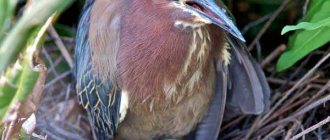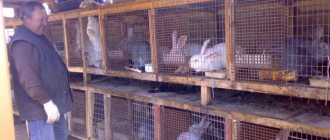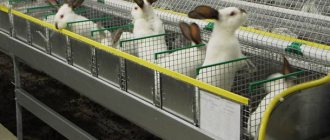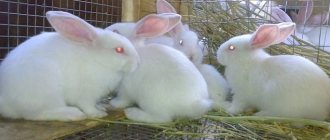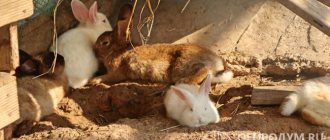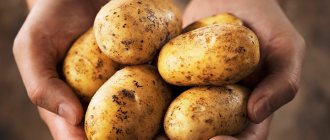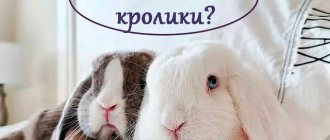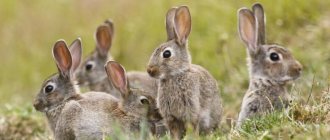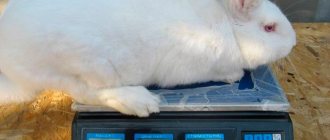Expert opinion
Dobryshev Sergey Anatolievich
Professional rabbit breeder and hare breeder with 30 years of experience
Rabbits differ from other domestic animals in their sexual maturation and reproduction. They are characterized by an early stage of puberty, a short period of pregnancy, the ability to combine feeding the offspring with milk and the onset of a second pregnancy (pregnancy). But, at the same time, the puberty of rabbits may differ slightly, depending on the breed, so it is necessary to consider the characteristics of each case.
At what age can rabbits be born?
Rabbits of early maturing breeds are physiologically ready for the first mating at 3–4 months, and late maturing ones at 6 months. However, the onset of puberty does not mean that the animal’s body is ready for pregnancy and childbirth. If you allow a female to mate at such an early age, there is a high risk of complications during birth. The offspring may be born weak or non-viable.
Some meat farms practice early breeding of rabbits of early maturing breeds - at the age of 4 months. Such females are called “disposable” because they bear offspring once in their lives and then are discarded. The purpose of such early mating is to quickly obtain young animals intended for meat. Good results are possible only with absolute health of the livestock and adequate feeding with special compounds.
For the first time, animals are allowed to mate no earlier than they are six months old. Representatives of late maturing breeds are ready to breed at 8–9 months. The indicated age is valid for females; the rabbit can be mated a couple of months earlier.
Forced or accidental inbreeding
Inbreeding or, more simply, inbreeding also occurs among experienced rabbit breeders. When keeping a herd together (in a pit, enclosure, etc.), random crossings periodically occur.
Another problem is the inability to find a match for your own animals that is suitable in terms of health, appearance or breed. Then inbreeding becomes forced.
Dozens of scientific papers have been written about the pros and cons of inbreeding, so without going into unnecessary details, we will give an example from practice. Even ancient pastoralists sought to exclude the crossing of closely related animals. It has been experimentally verified that regular inbreeding in a herd leads to degeneration. Although in laboratory conditions, inbreeding is practiced to breed new breeds.
Possibility of inbreeding when kept in a pit
If, for some reason, inbreeding does occur on your farm, then experienced rabbit breeders are guided by the following recommendations:
- They try in every possible way to prevent the crossing of born rabbits with other relatives on the paternal or maternal side. Based on this, in a small herd, all rabbits born from such a cross will most likely go to meat, and will not participate in reproduction in the future;
- With forced inbreeding, they try to select a couple with the weakest family ties possible, that is, distant relatives. Given the fertility of rabbits, this is quite realistic;
- All rabbits born with congenital defects, and there will be more and more of them with each subsequent inbreeding, must be removed from the herd.
How to tell if a female rabbit is in heat
To successfully breed rabbits, you need to know when you can assign a female to a male. She is ready to accept a rabbit not at any time, but only on certain days. The reproductive cycle of a female rabbit lasts on average 20–22 days. During this period, the egg matures and is ready for fertilization, the female can be mated. If the result does not occur, the female rabbit comes into heat again after 22 days.
You can tell that the female is ready for mating by her changed behavior:
- shows anxiety;
- refuses food, throws food out of feeders;
- runs around the cage;
- may start biting.
In some cases, the nursing female tramples the offspring and scatters them around the cage.
One of the signs of the onset of heat is swelling and redness of the female's genital loop.
Sometimes the female rabbit walks quietly, not outwardly showing any readiness for mating. In this case, you can determine if the female rabbit is in heat by letting the male near her. She is taken to the rabbit and placed in a cage for half an hour. If the female is not in heat, she will run away from the male, squeak displeasedly and even try to bite the intrusive gentleman. A female rabbit, ready to mate, will calmly allow the rabbit to cage.
A simple explanation of the meaning of reflex ovulation
A woman can become pregnant at a certain stage of her monthly cycle. At other times, pregnancy is not possible, although there are exceptions. For a female rabbit, any sex, regardless of the stage of the cycle, can result in pregnancy. Ovulation (the release of an egg) is stimulated by the movements of the penis in the vagina, not by the stage of the cycle. Add that sex in female rabbits, like in women and female dolphins, can occur outside the cycle. In other animals, sexual intercourse is possible only during estrus. Outside the cycle, the reproductive tract in normal females is closed, but in female rabbits it is not.
Up to what age can rabbits be born?
Depending on the health of the animal and the intensity of use, females are kept in a productive herd for up to 3–4 years. If problems with the appearance of heat and childbirth (the number of stillbirths increases, the female does not have enough milk for all the babies) appear before the age of 4, the female rabbit must be culled.
If we take as an example ordinary meat-skin rabbits with an average weight of 5 kg, then rabbits begin to be covered at the age of 6 months. During the year, a female receives 2–4 litters, sometimes 5–6 if intensive use is used. With 3 litters per year, the animal retains its reproductive qualities longer. With intensive breeding, the female rabbit is culled in the second year.
When animals are kept not in rabbit hutches, but on the street, the mating of rabbits depends on the weather - in the cold season the animals are at rest.
Features of choosing partners
The correct choice of rabbits for breeding determines what kind of offspring there will be and, accordingly, the profit from the animals. The process of selecting manufacturers should be approached with special care.
There are some criteria by which selection is made:
- live weight of the rabbit;
- amount of increase;
- immunity to diseases;
- fertility;
- milkiness;
- maternal instinct.
The main characteristics by which rabbits are selected for breeding:
- muscular, rounded croup;
- milk production of the rabbit;
- litter survival;
- number of live and dead newborns in the litter;
- the number of young animals surviving before weaning;
- total live weight of the offspring at three weeks of age;
- total live weight of babies at the time of weaning.
Determination of gender
Before you start breeding rabbits, you should determine their gender. This is not as simple as it might seem at first glance. Moreover, such an activity will seem difficult for a person who is encountering this for the first time.
To determine the sex, you need to place the rabbit on its back, lower its tail, and press with your fingers on both sides near the rabbit's genitals. In a female individual, the genitals look like a loop or hood with a slit (genital slit). In males, the genital organ is formed in the form of a tube with a round hole in the middle.
04:45
How to determine the sex of a rabbit//Female or male?
Choosing the right rabbit
Choosing a female rabbit for mating is not so difficult. First, assess the age of the animal: the female should not be younger than 6 months, since at a younger age she will not be able to bear offspring normally. Of course, the best option would be young individuals who have already given birth to rabbits and then conscientiously fed them. In this case, already 45 days after the previous litter, the female can be bred again.
It happens that a mother rabbit eats her babies. If this happened, there is no need for this female to happen again.
A female rabbit for breeding must correspond to the breed characteristics as much as possible
An equally important criterion for choosing a young rabbit to mate with is her weight. The female should be moderately well-fed, but not suffer from obesity. If the animal is thin, you should start fattening it. The female rabbit must be in the hunting stage, because without this the mating will not work. If a specific day of the month has been selected for mating, the female should be separated from her relatives for a while.
At what age can rabbits be bred?
To determine the age for mating as correctly as possible, one should take into account the fact that rabbits do not live long, about 9-10 years, and already from the 5th year of life the percentage of successful matings drops, therefore it is recommended not to mate. In addition, in old age there is a sharp decrease in the volume of milk in female rabbits after the birth of offspring, so the female cannot feed them on her own.
In rabbits, the process of aging and the extinction of maternal instincts is an individual feature . It often happens that, by all academic parameters, a male or female is subject to culling, but at the same time they still produce numerous and healthy offspring. But as statistics show, regardless of the age at which the first mating occurred, the animal can give birth to strong young rabbits during the first 2-3 years of its life.
How to choose rabbits?
When selecting rabbits for breeding, experienced rabbit breeders focus on the distinctive qualities of the animals:
- Lively temperamentDeep and wide chest;
- Resistance to heat and cold, strong immunity;
- Quick adaptation to new conditions;
- Elastic and dense skin;
- Thick, shiny coat without bald spots or excess plumpness;
- Regular and consistently high number of individuals in the offspring;
- Uniform and normal in duration breaks between births;
- Multiple births, milk production.
Culling of rabbits is carried out by excluding from the herd individuals that are partially or completely unsuitable for reproduction. Culling is carried out after several matings.
What is culling?
Rabbits are subject to culling, regardless of the condition, if they have physiological deficiencies:
- the chest is excessively narrow;
- weak muscles;
- the distinctive features of the breed, approved in accordance with standard requirements, are not particularly highlighted;
- the back is very concave or arched;
- croup sags, narrowed loin;
- the skin sags;
- the stomach is flabby, sagging;
- very large dewlap (not acceptable for males);
- underdeveloped or underdeveloped bones;
- the front legs are X- or O-shaped;
- the hind legs are very narrow or incorrectly formed;
- females have a coarse type of head, and males have a feminine, refined shape;
- the color and type of coat is atypical for this breed;
- wool with bald spots, sparse, patchy;
- the ears droop too much (with the exception of lop-eared rabbits) or are unacceptably thin.
Mating technologies
Large rabbit farms often use artificial insemination of rabbits in order to reduce the number of breeding males. Seeds are collected from the most valuable specimens, which can be stored for many years in special containers, deep frozen. To inseminate a female rabbit, a portion of semen is injected into her with a special syringe. The effectiveness of this method is high; a prerequisite is the necessary qualifications of veterinary specialists and the availability of equipment.
On small farms and when keeping animals indoors, natural mating is practiced. Rabbits begin to show interest in the opposite sex quite early, so young animals are sorted by gender already at the age of 3 months.
Terms of breeding use
The breed and feeding conditions of rabbits significantly affect their early maturity. If you want to further increase their early maturity, try to ensure that both the keeping and care of the rabbits are at their best. The first time the female begins to hunt at approximately three to four months, but it should be a fact for you that at this age the animal will not be able to bring you viable and vigorous babies. Healthy offspring can only be obtained from a normally developed female. Each individual breed of rabbit will be formed exclusively according to its own characteristics. For example, breeds such as Viennese blue or chinchilla will give birth to healthy offspring at approximately five months, and breeds such as giant (gray or white) at six months and their weight will be 3.5-3.8 kilograms.
Mating rabbits at this age will allow rabbit farms to develop well, and within one year you will receive offspring not from one rabbit, but also from her babies (grown up) from the initial and second litters. It is believed that a satisfactory litter can be obtained if your female is one year old. This is really so, because then they can not only bear offspring, but they will also have enough milk to feed the cubs up to the age of one and a half months. In addition, you will receive rabbits that will differ in size, resistance to various diseases and good immunity.
Mating schedule and male diet
When planning a breeding schedule for rabbits at home, it is necessary to correctly distribute the load on the producer. Depending on the age and breed, it can range from 1 to 3 rabbits per day.
The male is first allowed to work at the age of 5 months. An experienced female rabbit, who has already given birth, is being prepared for him and is in a pronounced heat. Bringing two young and inexperienced animals together may not be productive.
For a young male, a small load is set - 1 female every other day. Gradually the norm is increased to 3 individuals per day, provided that the male feels well. High strain on the producer can increase the percentage of unfertilized individuals.
Slow and phlegmatic giant rabbits are bred no more than once a day with a mandatory rest day twice a month.
To maintain high sexual activity, it is necessary to provide rabbits with a fortified and varied diet, preventing the animals from becoming obese. In the diet they use:
- cereal or meadow hay (brome, wheatgrass, vetch-oat mixture) - up to 250 g;
- oat and barley grain - up to 120 g;
- carrots, parsley root - up to 150 g.
Experienced rabbit breeders give their animals fresh pine needles, parsley, and sprouted oats to increase libido. In winter, the livestock is given a vitamin complex.
Care of offspring
If a young, inexperienced rabbit has not bothered with arranging the nest, the owner will have to take the process into his own hands and build a queen house himself. The manufactured “maternity hospital” is installed in a cage, the lower part of the nest is lined with down and straw.
After giving birth, it is necessary to place the female in another cage and carefully examine the litter. Dead cubs should be removed immediately. Otherwise, the rabbit may refuse to feed her offspring. The inspection of the nest is carried out with gloves; the female rabbit should not smell human odor in the uterine house. Newborn pets are examined daily and, if necessary, consult a veterinarian.
After reaching 20 days of age, babies are treated to sprouted grains, grated carrots and granulated grass.
45 days after birth, the rabbits are separated from their mother and placed in separate apartments. At the age of 2 months, rabbits are transferred to regular food for adult animals.
How to breed rabbits correctly
Beginning rabbit breeders need to know how rabbits are mated at home. The normal process goes like this:
- A female in heat is placed next to a selected male in a cage.
- The rabbit sniffs the female rabbit, sometimes lightly biting her fur. She lifts her sacrum and lifts her ponytail up.
- The male attaches himself to the female rabbit and intercourse occurs. It lasts for several seconds, after which the rabbit falls on its side with a characteristic loud squeak. This signals ejaculation.
- Repeated intercourse may occur within a few minutes.
It is not recommended to leave the female rabbit with the male all night. During this time, he can bring up to 10 cages, which significantly depletes the rabbit’s strength and is harmful to the female.
Coating process
Now let's find out how to breed rabbits for the first and subsequent times. In small farms where it is not possible to carry out artificial insemination, two mating methods are practiced:
- Adding a female rabbit to a male for a long period of time - 5-7 days . In this situation, the animals themselves will decide on the optimal mating option. At first, it is advisable to observe the animals. Cases of fights if you don’t like your partner are not uncommon. If the partners are aggressive and the matter ends in a fight, then the animals should be seated to avoid serious injury;
- The second option is a short-term replanting of the female for 2-3 hours . The disadvantage of this method is the need for constant monitoring and, possibly, intervention by the rabbit breeder. Determining the moment of coverage visually is not difficult. It lasts for half a minute. After covering, the rabbit falls over on its side and emits a characteristic squeak - a signal to the rabbit breeder that the partners can be seated. If the partners flirt too much and do not have intercourse, then experienced rabbit keepers simply hold the female rabbit with their hands, allowing the male to do his job faster.
Mating rabbits in winter
Breeding rabbits in winter can be difficult, not only because of the cold, but also because of the short daylight hours. If animals are indoors, fluorescent lamps are turned on for them, extending the daylight hours to 10–14 hours.
Female rabbits kept outside or in sheds stop coming into heat in the fall. Hormonal levels are restored in March - April. To “deceive” nature, animals are injected with a complex of vitamins (vitamin E is responsible for reproductive function). Rabbits can be temporarily placed in a warm, bright room to encourage the onset of heat.
When can you give birth to a female rabbit after giving birth?
Theoretically, the female is ready for fertilization already on the 5th–7th day after birth. A special feature of the animals is the ability to combine feeding existing offspring with a new pregnancy. However, this is a large burden on the mother’s body, which leads to early aging of the rabbit.
The female should be covered no earlier than 1.5–2 months after birth. This coincides with the birth of the previous offspring and gives the mother the opportunity to rest for a month before the next litter.
What to do if the female rabbit does not want to mate
Mating of rabbits is impossible if the female does not allow the male to approach her. This happens for several reasons:
- the female rabbit is exhausted from previous births and feeding offspring;
- the female has become fat;
- advanced age of the animal;
- The time of year is not conducive to hunting.
Sometimes a rabbit experiences a hormonal imbalance, which is difficult to determine with a routine examination. If an animal, with proper care and feeding, does not show readiness for mating, it can be stimulated by administering special drugs: Folligon, Folimag. The solution is administered to individuals subcutaneously or intramuscularly, according to the instructions.
Animal culling
There are frequent situations when a manufacturer loses its status. There are several reasons:
- Rare or, on the contrary, too frequent matings lead to the loss of the positive properties of the sire;
- The onset of the “limit” age. The best offspring are from rabbits 1-2 years of age;
- The presence of a disease leading to frequent miscarriages. The death of several litters in a row indicates that the rabbit has listeriosis, a dangerous disease that is inherited;
- The loss of maternal instinct in a female rabbit, leading to the destruction of her own offspring, is a clear sign of the animal’s unsuitability for further reproduction;
The fertility of rabbits gives their owner ample opportunities for selection. Therefore, if due to some individual characteristics there are doubts about the suitability of a rabbit for reproduction, then it is better to replace it.
Male culling
How to determine pregnancy
After mating, the female completely loses interest in the rabbit and may become aggressive. One of the simplest ways to check for pregnancy is a male test. The covered rabbit runs away from the rabbit or attacks it.
Experienced rabbit breeders can feel the embryos in the female’s abdomen 14–16 days after mating. To do this, the rabbit is placed on a flat surface and her lower abdomen is carefully felt. The fruits during this period are the size of a walnut and are soft to the touch.
If the female rabbit is not pregnant and does not become pregnant for 2-3 months, she is subject to culling.
Advice from experienced rabbit breeders
One of the main advantages of rabbit breeding is the ability of animals to reproduce quickly. Having several females, in just a year you can increase the population to hundreds of individuals.
Beginner rabbit breeders are advised to:
- mate rabbits that have reached the age of 6–9 months;
- choose unrelated healthy animals;
- receive no more than 4 litters per year from a female.
Caring for the animals guarantees good health of the livestock and numerous births. It is important to consider the age and condition of the animals. You cannot breed sick or weak individuals - their offspring will be frail and non-viable.
Possible problems
For a new farmer, it may seem that once the babies are born, all the worries are left behind. Unfortunately, this is not the case at all.
- Sometimes a joyful event is overshadowed by the death of newborn rabbits. The cause of misfortune may be hunger. The validity of this assumption can be judged by the appearance of the babies. Starving rabbits have indented tummies and wrinkled skin. In order to avoid a sad event, you need to monitor the quality of the diet and the health of the rabbit.
- In some cases, the female throws the cubs away from her. As a rule, the reason for aggression lies in the onset of the hunting period. Another mating with a long-eared gentleman can calm the young mother down.
- The children's early attempts to get out of their native nest indicate the ill-being of the offspring. In this way, baby rabbits look for food. In this case, you need to examine the female's mammary glands. The rabbit's nipples are probably sore or there is no milk at all. The only way out of a difficult situation is artificial feeding of pets.
Source
